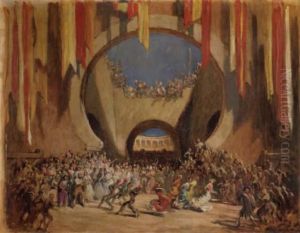Panos Aravantinos Paintings
Panos Aravantinos was a distinguished Greek artist, renowned for his contributions to the world of theatre design, scenery, and costume creation. Born in 1893 in Athens, Greece, Aravantinos was part of a cultural milieu that was rapidly absorbing and adapting various European artistic movements, blending them with the rich heritage of Greece. His early life was steeped in an environment that appreciated arts and literature, which significantly influenced his eventual career path.
Aravantinos pursued his education in fine arts with a focus on theatre design, a field that was gaining prominence in the early 20th century. His talent quickly became evident, and he soon emerged as a leading figure in the Greek theatre scene. His work was not limited to Greece; Aravantinos also spent a considerable amount of time in other European countries, where he absorbed influences and techniques that he would later integrate into his own unique style.
Throughout his career, Panos Aravantinos was known for his innovative approach to theatre design. He was adept at creating atmospheres that enhanced the narrative and emotional impact of theatrical productions. His designs were characterized by a keen attention to detail, a masterful use of color, and an ability to evoke a strong sense of time and place. Aravantinos's contributions extended beyond the visual; he was deeply involved in the conceptual aspects of productions, working closely with directors and playwrights to ensure a cohesive and impactful audience experience.
Aravantinos's work had a profound impact on the development of theatre design in Greece and influenced subsequent generations of designers. His legacy is preserved in various archives and collections that house his sketches, designs, and costumes, offering insight into his creative process and artistic vision. Panos Aravantinos died in 1957, leaving behind a body of work that continues to be celebrated for its artistic merit and its significant role in the evolution of Greek theatre.

